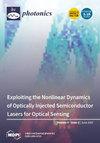Optimal Scanning Pattern for Initial Free-Space Optical-Link Alignment
IF 2.1
4区 物理与天体物理
Q2 OPTICS
引用次数: 0
Abstract
Since free-space optical links (especially fully photonic ones) are very challenging to accurately align; scanning algorithms are used for the initial search and alignment of the transceivers. The initial alignment aims to intercept the optical beam so that it hits a position-sensitive detector. However, this operation can be very time-consuming (depending on the system parameters, such as transceiver parameters, distance between transceivers, divergence of the transmitter, angle of view of the receiver, etc.). A spiral scan is used as the most widespread pattern for scanning. This article examines the effects of system parameters (e.g., global navigation satellite systems and compass accuracy) on the angular area of uncertainty that must be scanned to find the optical beam. Furthermore, several types of spiral pattern are compared depending on the time of the scan execution and the required number of points for scanning the given uncertainty area. The cut hexagonal spiral scan achieved the best results as it required 18.1% less time than the common spiral scan for the presented transceiver.初始自由空间光链路对准的最佳扫描模式
由于自由空间光链路(尤其是全光子链路)的精确对准非常具有挑战性,因此扫描算法被用于收发器的初始搜索和对准。初始对准的目的是截取光束,使其命中位置敏感探测器。然而,这一操作可能非常耗时(取决于系统参数,如收发器参数、收发器之间的距离、发射器的发散角、接收器的视角等)。螺旋扫描是最常用的扫描模式。本文探讨了系统参数(如全球导航卫星系统和罗盘精度)对寻找光束所必须扫描的不确定角度区域的影响。此外,还比较了几种螺旋模式,具体取决于执行扫描的时间和扫描给定不确定区域所需的点数。切割六边形螺旋扫描取得了最佳效果,因为它比普通螺旋扫描所需的时间少 18.1%。
本文章由计算机程序翻译,如有差异,请以英文原文为准。
求助全文
约1分钟内获得全文
求助全文
来源期刊

Photonics
Physics and Astronomy-Instrumentation
CiteScore
2.60
自引率
20.80%
发文量
817
审稿时长
8 weeks
期刊介绍:
Photonics (ISSN 2304-6732) aims at a fast turn around time for peer-reviewing manuscripts and producing accepted articles. The online-only and open access nature of the journal will allow for a speedy and wide circulation of your research as well as review articles. We aim at establishing Photonics as a leading venue for publishing high impact fundamental research but also applications of optics and photonics. The journal particularly welcomes both theoretical (simulation) and experimental research. Our aim is to encourage scientists to publish their experimental and theoretical results in as much detail as possible. There is no restriction on the length of the papers. The full experimental details must be provided so that the results can be reproduced. Electronic files and software regarding the full details of the calculation and experimental procedure, if unable to be published in a normal way, can be deposited as supplementary material.
 求助内容:
求助内容: 应助结果提醒方式:
应助结果提醒方式:


